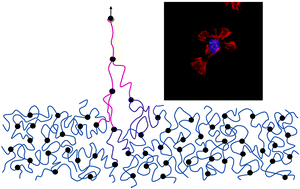The mechanics of single cross-links which mediate cell attachment at a hydrogel surface†
Abstract
The response of cultured cells to the mechanical properties of hydrogel substrates depends ultimately on the response of single crosslinks to external forces exerted at cell attachment points. We prepared hydrogels by co-polymerization of poly(ethylene glycol diacrylate) (PEGDA) and carboxy poly(ethylene glycol) acrylate (ACPEG-COOH) and confirmed fibroblast spreading on the hydrogel after the ACPEG linker was functionalized with the RGD cell adhesive motif. We performed specific force spectroscopy experiments on the same ACPEG linkers in order to probe the mechanics of single cross-links which mediate the cell attachment and spreading. Measurements were performed with tips of an atomic force microscope (AFM) functionalized with streptavidin and ACPEG linkers functionalized with biotin. We compared hydrogels of varying elastic modulus between 4 and 41 kPa which exhibited significant differences in cell spreading. An effective spring constant for the displacement of single cross-links at the hydrogel surface was derived from the distributions of rupture force and molecular stiffness. A factor of ten in the elastic modulus E of the hydrogel corresponded to a factor of five in the effective spring constant k of single crosslinks, indicating a transition in scaling with the mesh size ξ from the macroscopic E ∝ ξ−3 to the molecular k ∝ ξ−2. The quantification of stiffness and deformation at the molecular length scale contributes to the discussion of mechanisms in force-regulated phenomena in cell biology.



 Please wait while we load your content...
Please wait while we load your content...